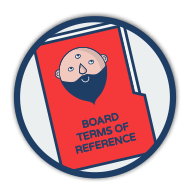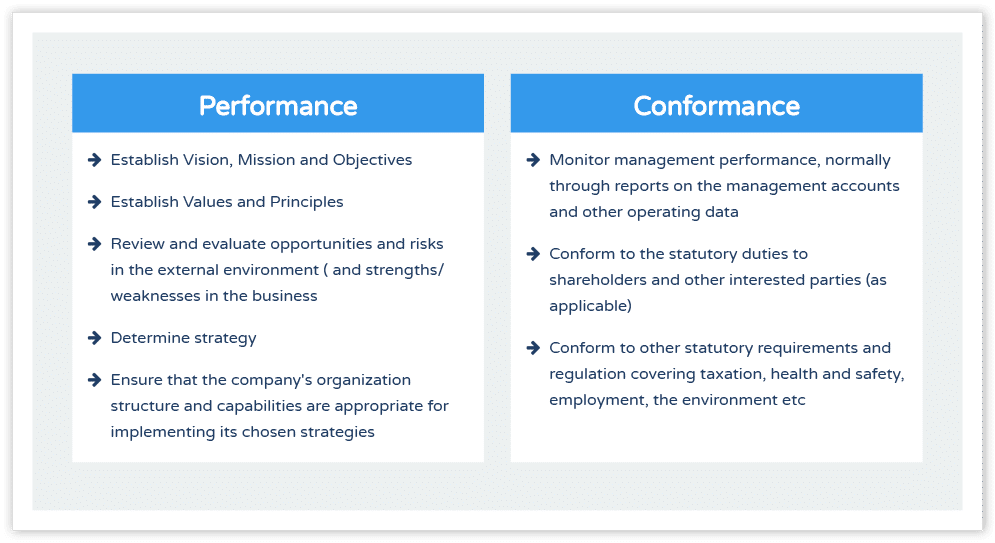An invariable indicator of the meandering masses - Born out of corporate scandal and demise - Work smart (as well as hard) - Performance and conformance - The value of NEDs - Corporate theatre
In one of my earliest blogs, I talked about what makes a professional service firm successful. Specifically, I detailed ten aspects that were certainly important in my own company-build journey and that I have subsequently noted appear commonly in successful, high-growth organizations. In this essay, I talk about one of these – an effective board of directors – and why this needs to be a critical component of your firm’s governance (even at an early stage!).
Building an effective board of directors
I should say, specifically, that an effective board of directors and keeping on top of the discipline of regular board sessions is – without doubt – one of the key determinants to company build success I have observed. Like a business plan, the existence of a board discipline is not an infallible guarantor of forward success. I can say with near certainty, however, that businesses that do not instal such a regular, critical, part-independent, strategic, directional oversight of their affairs – invariably just meander along.

Corporate governance, as a topic, really emerged in the 1990s. Certainly so, in the US and UK, amidst the scandals of BCCI, Polly Peck, Guinness, Maxwell and – into the 2000s – with Enron and Worldcom. For large, listed companies the topic of the board, and the role of the company director, became increasingly regulated and focused upon as a plethora of enquiries (Greenbury, Turnbull, Higgs, Combined Code, Sarbanes-Oxley etc) sought to get under the skin of what had gone wrong in such infamous instances of corporate failure.
But, what has all this got to do with fledgling, owner-managed start-ups I hear you ask?
Well, in relation to the question of how you build a high-performing business – regardless of size and ownership structure – it is very important. Many of the lessons learned are directly translatable!
At the centre of this topic, is the role of the board. I would strongly advocate the establishment of an effective board from the earliest moments – even if you are a sole owner and this all feels a bit too grown-up for your stage of corporate development. The reason for this is that the existence of an effective board of directors accentuates the key difference between directing a business (working on it) and managing a business (working in it). The board focuses on the former and without it you are more likely to succumb to the very common situation of working hard but not smartly.
Please send me
My example board terms of reference

You see, most common themes of corporate failure are to do with misdirection not mismanagement.
There are tomes of guidance on the purpose, structuring and roles of boards, so I only want to point you to the headline, salient features here with an emphatic reinforcement of how key an element I believe this is in the architecture of a high-potential firm.
At its simplest level, the role of an effective board of directors is to do with performance and conformance as the following diagram illustrates. Its key tasks, therefore, are to do with foresight, strategic thinking and high-level oversight of the operational elements of the business.

Figure: Role of the board
In terms of structure, to best achieve this, there needs to be a mix of talent and representation but don’t feel this means a large construct. Even successful $billion-revenue PLCs are run by boards of less than ten members; certainly anything larger can quickly become dysfunctional.
At a certain size, and stage of growth, the separation of Chairman and Chief Executive is a key (and, in my mind, desirable) feature. From the very outset, however, I would strongly advocate including in this composition one or (ideally) two non-executive directors (NEDs). Well selected, these individuals can make an inordinate difference to your firm’s direction and, therefore, success.
At a practical level, you clearly have a firm to run so, whilst it is important that you build in this aspect of your firm’s organisation, board members can’t spend all their time preparing for, and attending, board meetings. The right balance and frequency is a question for you but a very typical arrangement is a quarterly, half-day meeting. A typical agenda will cover the aspects of the figure above as well as any additional, specific items (Reserved Matters) that the company has specified as being of board-level significance.
ACTIVITY
If you have yet to constitute a board, do so now. Ask around for well-referred, relevant non-executives. In advance of the inaugural session, start to complete a Terms of Reference (ToR) document for this forum (an important document that stipulates its composition, function, reserved matters, delegated authorities etc). You can sign up for a free example template ToR below.
Please send me
My example board terms of reference

Let me conclude this blog, with a look back to the early years of building Moorhouse Consulting. I established this board at the earliest viable moment, at the start of our second trading year when we were a team of just over ten. There were six members initially. Four executive members and two non-executives – one chosen because he had experience of building and selling a professional service business and the other was our company accountant essentially stepping up to a FD-type role.
Initially, we met every quarter for half a day; over time, as the firm grew, board membership grew to ten and the agenda necessitated four whole-day meetings per year.
I can say, with some conviction, that this construct and discipline was one of the critical success factors in the firm’s success. From my perspective as the MD, it kept us all honest to the plans we had set and brought innovation, and a self-determining confidence, to the decisions being made. The non-executives were absolutely essential; many a time they made suggestions we were unlikely to have derived on our own; indicated a trap to avoid; or strengthened our resolve to a certain cause of action when we might have succumbed to a safer, more pedestrian route. Certainly their per diem charge was but a fraction of the value we derived from their participation in these regular strategic huddles.
On reflection, there is always a little bit of corporate theatre involved in board meetings, but even this became a very positive dynamic. Everybody raised their game for board days – keen to demonstrate their intellectual contribution in the development of the business. We invariably all left the meetings rejuvenated and charged up for the quarter ahead. It certainly raised my game and, as such, I believe a an effective board of directors is a powerful foil, and ally, for any professional service firm entrepreneur.
so, time to refresh or build your company board?
So, what’s next?
Next week, as triggered by a reader request, I am going to talk about capability transfer to your clients – what it means, why it is so important to get beyond the sound-bite of this topic and how you should think about adding it to your service proposition menu.
Hopefully, you’ll join us on this journey. It’s totally free, and you don’t have to be a Method Grid customer (though you’re more than welcome to sign up for a free trial here).
We’ll be releasing a new post each week. To get each post emailed to you as soon as it’s published, sign up for the Climbing Mount Audacity mailing list below.
Climbing Mount Audacity…
From Startup to Scaleup!
We're sharing everything we know about how to build an awesome professional service firm (and enjoy the journey en route!) PLUS travel updates, reflections on our stumbles and general musings on our Method Grid journey.
Signup below to get the latest articles
direct to your inbox.
See you next week. Have something you want to hear more about? Let me know in the comments below or via Twitter.

 Project and Program Management
Project and Program Management  Project Governance Framework
Project Governance Framework  Benefits Management Framework
Benefits Management Framework 






